
Welcome to www.rockhoundstation1.com's
Earthwatch E-zine:
Updates and news on Earthquakes, Volcanos, climate change, global warming, Hurricanes.
RHS1 Global rockhound community environmental news E-zine. monitoring, earthquakes, global warming, climate change, hurricanes and tornados, bio-diversity, keeping an eye on our fast changing planet.
Issue 14: March 2011: Editor Robert Velare: www.rockhoundstation1.com
In this issue:Editorial RHS1...Japan emergency :-160 FREE e-books.
Scroll down for UPDATES...
*SPECIAL EDITION*
""
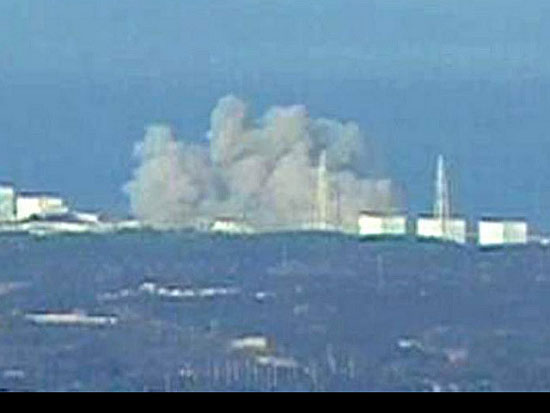
Meltdown Japan!
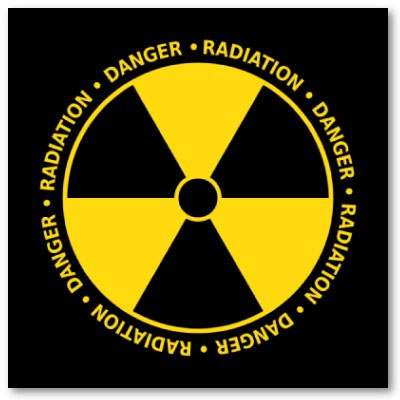



Welcome to this special edition of RHS1 Earthwatch...
A senior nuclear industry executive has told the New York Times that Japanese nuclear power industry managers are "basically in a full-scale panic". The executive is not involved in managing the response to the reactors' difficulties but has many contacts in Japan. "They're in total disarray, they don't know what to do," the executive added.
OK...Thats the way I assumed it was when I focused in on this bad news. Below is a Sat photo of the plant/site...14/3/11 Click to enlarge then click again for detail...
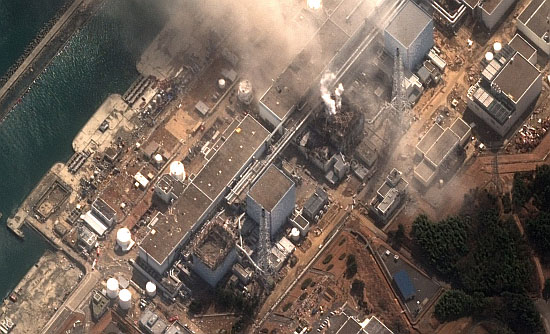
"Look at the state of it"...Draw your own conclusions...Questions...
Where are the used fuel rods...That where stored in the roof section of each reactor containment structure?...Where is the nucelar waste after the water passed? See how close it is to the sea!...Lots of questions here folks...
Probably all over Japan... More soon...Indy
***************
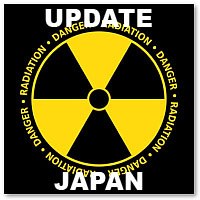
15 March 2011
"Tel Aviv - An Israeli nuclear expert has accused Japan of downplaying the danger of a nuclear calamity in the region of its quake-stricken Fukushima Daiichi plant. 'If there is fallout of plutonium oxide, a most toxic substance that they use in the reactor that exploded, no one will be able to set foot on the site for thousands of years,' said Uzi Even, one of Israel's most prominent nuclear scientists, "
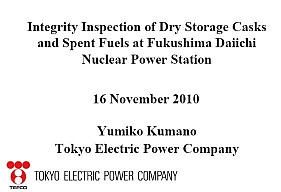
Click image above for PDF inventory of Fukushima Daiichi plant.
As of 2010: the following were located on the site
- 3450 fuel assemblies were stored in pools inside the reactor buildings
- 408 fuel assemblies were stored in dry casks
- 6291 fuel assemblies were stored in a common storage pool.
Why is this important?
"The pools are a worry at the stricken reactors at the Fukushima Daiichi plant because at least two of the three have lost their roofs in explosions, exposing the spent fuel pools to the atmosphere. By contrast, reactors have strong containment vessels that stand a better chance of bottling up radiation from a meltdown of the fuel in the reactor core.
Were the spent fuel rods in the pools to catch fire, nuclear experts say, the high heat would loft the radiation in clouds that would spread the radioactivity.
"It's worse than a meltdown," said David A. Lochbaum, a nuclear engineer at the Union of Concerned Scientists who worked as an instructor on the kinds of General Electric reactors used in Japan. "The reactor is inside thick walls, and the spent fuel of Reactors 1 and 3 is out in the open."
*****
As Robert Alvarez, a former nuclear energy adviser to President Bill Clinton, has written, if these waste containers, euphemistically called "ponds," were to be damaged in an explosion and lose their cooling and radiation-shielding water, they could burst into flame from the resulting burning of the highly flammable zirconium cladding of the fuel rods, blasting perhaps three to nine times as much of these materials into the air as was released by the Chernobyl reactor disaster. (And that's if just one reactor blows!) Each pool, Alvarez says, generally contains five to ten times as much nuclear material as the reactors themselves. Alvarez cites a 1997 Nuclear Regulatory Commission study that predicted that a waste pool fire could render a 188-square-mile area"uninhabitable" and do $59 billion worth of damage (but that was 13 years ago).
Another nuclear scientist agrees with Alvarez, quoted in an article in the Christian Science Monitor:
"There should be much more attention paid to the spent-fuel pools," says Arjun Makhijani, a nuclear engineer and president of the anti-nuclear power Institute for Energy and Environmental Research. "If there's a complete loss of containment [and thus the water inside], it can catch fire. There's a huge amount of radioactivity inside - far more than is inside the reactors. The damaged reactors are less likely to spread the same vast amounts of radiation that Chernobyl did, but a spent-fuel pool fire could very well produce damage similar to or even greater than Chernobyl."
****
So that appears to be the real danger in this event...
***********
- Today...10 times the normal levels of radiation 100 klm east of Tokyo...
- It is reported that the control room of the site is now radio-active...That won't help....
More soon...Indy
.....

Time line...Latest news...Click me
Stay tuned...Indy...Fair use cited...
Incoming Still today 15/3/11
QUOTE
"Hydrogen is a by-product of the oxidation that occurs WHEN THE FUEL RODS MELT. There is no process in working nuclear reactor that produces Hydrogen. Hot boiling water turns to STEAM NOT HYDROGEN. Why is this important? It is absolute proof that 1. the fuel rods were melting LONG before it was being reported. 2. Every reactor that has "exploded" is in the process of melting.
Yes, these reactors have a means of "sucking" hydrogen gas out of the top the reactor. But it wouldn't then be just vented right into the outer shell of the containment units. These "outer shells" are indeed superficial, but there would not be a mechanism to simply "vent" explosive gas into these chambers. That would be the equivalent to venting your cars exhaust into your passenger compartment to "lower emissions".
These reactors would have had a hydrogen diffusion systems. Called hydrogen diffusion rings. These systems "leak" hydrogen in a diffuse manner and mixes it with ambient air to reduce concentrations. These systems can be either active or passive and would be routed to the outside of the reactors. Even if the hydrogen inside this system were to explode it would never explode in the way the reactor housing buildings went up.
So heres my take:
Quake, Tsunami, Pumps Fail, Water Drops, Temp rises, Pressure Increases, Rods Are Exposed, Emergency Cooling System Fails, Rods Start Melting, Hydrogen Gas is produced, Pressure Builds
THEN...
The reactors wall's breached, hydrogen rushes out and boom!
Official Version: Hydrogen Gas was removed and stored in outer shell until BOOM!
Official Version does not pass the litmus test... does it?
Why would you intentionally blow the outer shell off a nuclear reactor? Especially when there is no reason to. "
*********

16 March 2011
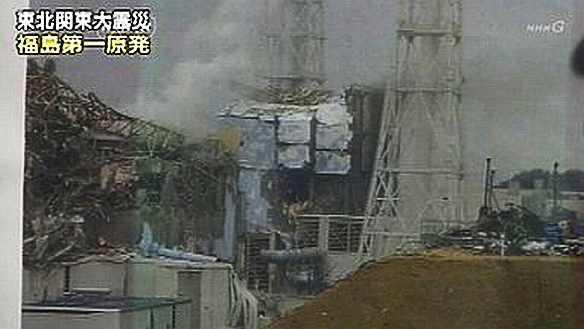
Tokyo Electric Power Company has released a photograph of the No.4 reactor building at the Fukushima Daiichi nuclear power plant where fires were reported on Tuesday and Wednesday.
It shows that a large portion of the building's outer wall has collapsed.
The company produced the photo at a news conference on Wednesday.
Japan's chief cabinet secretary, Yukio Edano, is holding a news conference that is being broadcast live on Japanese television. Mr. Edano said radiation readings started rising rapidly Wednesday morning outside the front gate of the Fukushima Daiichi plant. "All the workers there have suspended their operations. We have urged them to evacuate, and they have," he said, according to a translation by NHK television
********

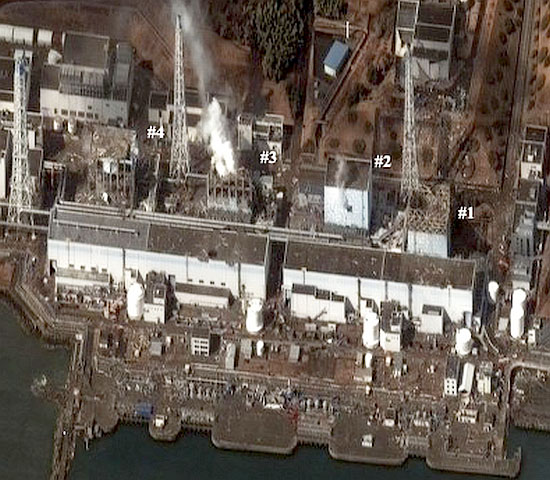
Image credit: www.digitalglobe.com
OK...Confusion, wreckage, questions?...Keyword in this story "MOX" thats the freakout, the real story in ducktown...What the hell is mox?...Hey Forbes magazine over here...
"The number 3 nuclear reactor at Japan's Fukushima Dai-Ichi complex is feared damaged and leaking radioactive steam, according to Chief Cabinet Secretary Yukio Edano.
While all six of the nuclear reactors at Japan's Fukushima Dai-Ichi complex contain dangerous amounts of radioactive materials, the threat of a catastrophic failure at number 3 is particularly worrisome. That's because No. 3 alone uses a fuel containing plutonium - a toxic metal that, if inhaled, remains in the body and can cause many forms of cancer.
The fuel in No. 3 is a blend of plutonium and reprocessed uranium, referred to as MOX (for mixed oxide) and manufactured by the French nuclear company AREVA. MOX fuel rods are also less stable than plutonium-free rods.
No. 3 contains 32 MOX fuel rods, or about 5 percent of the total, according to Arjun Makhijani, president of the Institute for Energy and Environmental Research, an anti-nuclear power organization which is considered a credible source of information.
No U.S. nuclear power plants use MOX, stemming from a 1977 ban by the Carter Administration on reprocessing uranium for domestic nuclear power. That is scheduled to change, however, as the National Nuclear Security Administration gears up for a program to produce MOX fuel at a plant now under construction at the Department of Energy's Savannah River Site in South Carolina. According to the NNSA's website:"
Read it all click here
Then Google "mox fuel danger"...
OK...I am needed on level 1 ??? Handing this subject over to Sherri...Tune in folks for further updates

24 March 2011
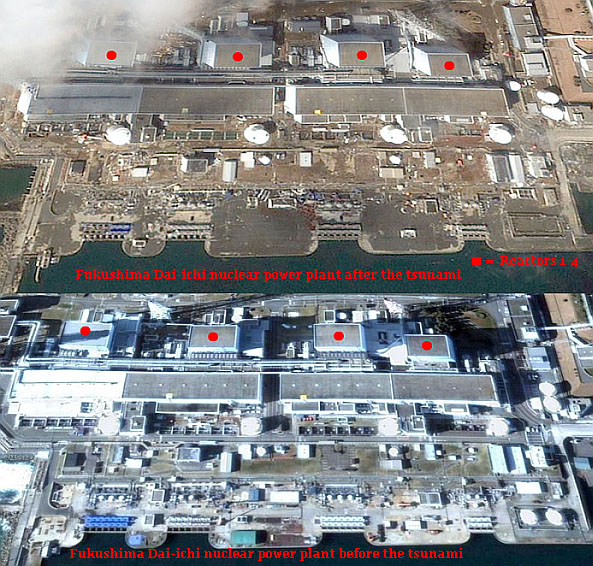
Bottom image: Before 11/3/2011:...Top image: after 11/3/2011...
Note the reactor buildings are still intake after 11/3/2011.
What They're Covering Up at Fukushima
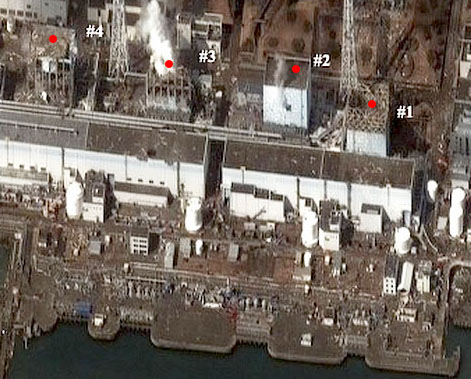
The reactor buildings 17/3/2011...
What They're Covering Up at Fukushima ?
By HIROSE TAKASHI... Introduced by Douglas Lummis
Okinawa
Hirose Takashi has written a whole shelf full of books, mostly on the nuclear power industry and the military-industrial complex. Probably his best known book is Nuclear Power Plants for Tokyo in which he took the logic of the nuke promoters to its logical conclusion: if you are so sure that they're safe, why not build them in the center of the city, instead of hundreds of miles away where you lose half the electricity in the wires?
He did the TV interview that is partly translated below somewhat against his present impulses. I talked to him on the telephone today (March 22 , 2011) and he told me that while it made sense to oppose nuclear power back then, now that the disaster has begun he would just as soon remain silent, but the lies they are telling on the radio and TV are so gross that he cannot remain silent.
I have translated only about the first third of the interview (you can see the whole thing in Japanese on you-tube), the part that pertains particularly to what is happening at the Fukushima plants. In the latter part he talked about how dangerous radiation is in general, and also about the continuing danger of earthquakes.
After reading his account, you will wonder, why do they keep on sprinkling water on the reactors, rather than accept the sarcophagus solution [ie., entombing the reactors in concrete. Editors.] I think there are a couple of answers.
One, those reactors were expensive, and they just can't bear the idea of that huge a financial loss. But more importantly, accepting the sarcophagus solution means admitting that they were wrong, and that they couldn't fix the things. On the one hand that's too much guilt for a human being to bear.
On the other, it means the defeat of the nuclear energy idea, an idea they hold to with almost religious devotion. And it means not just the loss of those six (or ten) reactors, it means shutting down all the others as well, a financial catastrophe.
If they can only get them cooled down and running again they can say, See, nuclear power isn't so dangerous after all. Fukushima is a drama with the whole world watching, that can end in the defeat or (in their frail, I think groundless, hope) victory for the nuclear industry. Hirose's account can help us to understand what the drama is about. Douglas Lummis
Hirose Takashi: The Fukushima Nuclear Power Plant Accident and the State of the Media
Broadcast by Asahi NewStar, 17 March, 20:00
Interviewers: Yoh Sen'ei and Maeda Mari
Yoh: Today many people saw water being sprayed on the reactors from the air and from the ground, but is this effective?
Hirose: . . . If you want to cool a reactor down with water, you have to circulate the water inside and carry the heat away, otherwise it has no meaning. So the only solution is to reconnect the electricity. Otherwise it's like pouring water on lava.
Yoh: Reconnect the electricity - that's to restart the cooling system?
Hirose: Yes. The accident was caused by the fact that the tsunami flooded the emergency generators and carried away their fuel tanks. If that isn't fixed, there's no way to recover from this accident.
Yoh: Tepco (Tokyo Electric Power Company, owner/operator of the nuclear plants) says they expect to bring in a high voltage line this evening.
Hirose: Yes, there's a little bit of hope there. But what's worrisome is that a nuclear reactor is not like what the schematic pictures show (shows a graphic picture of a reactor, like those used on TV). This is just a cartoon. Here's what it looks like underneath a reactor container (shows a photograph). This is the butt end of the reactor. Take a look.
It's a forest of switch levers and wires and pipes. On television these pseudo-scholars come on and give us simple explanations, but they know nothing, those college professors. Only the engineers know. This is where water has been poured in. This maze of pipes is enough to make you dizzy. Its structure is too wildly complex for us to understand. For a week now they have been pouring water through there. And it's salt water, right?
You pour salt water on a hot kiln and what do you think happens? You get salt. The salt will get into all these valves and cause them to freeze. They won't move. This will be happening everywhere. So I can't believe that it's just a simple matter of you reconnecting the electricity and the water will begin to circulate.
I think any engineer with a little imagination can understand this. You take a system as unbelievably complex as this and then actually dump water on it from a helicopter - maybe they have some idea of how this could work, but I can't understand it.
Yoh: It will take 1300 tons of water to fill the pools that contain the spent fuel rods in reactors 3 and 4. This morning 30 tons. Then the Self Defense Forces are to hose in another 30 tons from five trucks. That's nowhere near enough, they have to keep it up. Is this squirting of water from hoses going to change the situation?
Hirose: In principle, it can't. Because even when a reactor is in good shape, it requires constant control to keep the temperature down to where it is barely safe. Now it's a complete mess inside, and when I think of the 50 remaining operators, it brings tears to my eyes.
I assume they have been exposed to very large amounts of radiation, and that they have accepted that they face death by staying there. And how long can they last? I mean, physically. That's what the situation has come to now. When I see these accounts on television, I want to tell them, "If that's what you say, then go there and do it yourself!"
Really, they talk this nonsense, trying to reassure everyone, trying to avoid panic. What we need now is a proper panic. Because the situation has come to the point where the danger is real.
If I were Prime Minister Kan, I would order them to do what the Soviet Union did when the Chernobyl reactor blew up, the sarcophagus solution, bury the whole thing under cement, put every cement company in Japan to work, and dump cement over it from the sky. Because you have to assume the worst case.
Why? Because in Fukushima there is the Daiichi Plant with six reactors and the Daini Plant with four for a total of ten reactors. If even one of them develops the worst case, then the workers there must either evacuate the site or stay on and collapse.
So if, for example, one of the reactors at Daiichi goes down, the other five are only a matter of time. We can't know in what order they will go, but certainly all of them will go. And if that happens, Daini isn't so far away, so probably the reactors there will also go down. Because I assume that workers will not be able to stay there. I'm speaking of the worst case, but the probability is not low. This is the danger that the world is watching. Only in Japan is it being hidden. As you know, of the six reactors at Daiichi, four are in a crisis state.
So even if at one everything goes well and water circulation is restored, the other three could still go down. Four are in crisis, and for all four to be 100 per cent repaired, I hate to say it, but I am pessimistic. If so, then to save the people, we have to think about some way to reduce the radiation leakage to the lowest level possible.
Not by spraying water from hoses, like sprinkling water on a desert. We have to think of all six going down, and the possibility of that happening is not low. Everyone knows how long it takes a typhoon to pass over Japan; it generally takes about a week. That is, with a wind speed of two meters per second, it could take about five days for all of Japan to be covered with radiation.
We're not talking about distances of 20 kilometers or 30 kilometers or 100 kilometers. It means of course Tokyo, Osaka. That's how fast a radioactive cloud could spread. Of course it would depend on the weather; we can't know in advance how the radiation would be distributed. It would be nice if the wind would blow toward the sea, but it doesn't always do that. Two days ago, on the 15th, it was blowing toward Tokyo. That's how it is. . .
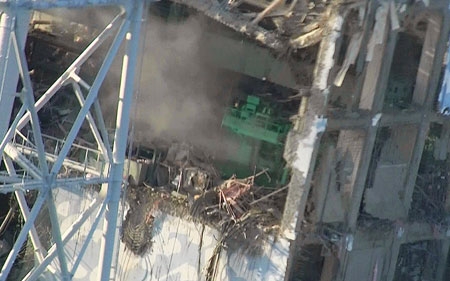
The fuel rod cooling pool reactor 4; 17/3/2011.
Yoh: Every day the local government is measuring the radioactivity. All the television stations are saying that while radiation is rising, it is still not high enough to be a danger to health. They compare it to a stomach x-ray, or if it goes up, to a CT scan. What is the truth of the matter?
Hirose: For example, yesterday. Around Fukushima Daiichi Station they measured 400 millisieverts - that's per hour. With this measurement (Chief Cabinet Secretary) Edano admitted for the first time that there was a danger to health, but he didn't explain what this means. All of the information media are at fault here I think. They are saying stupid things like, why, we are exposed to radiation all the time in our daily life, we get radiation from outer space. But that's one millisievert per year. A year has 365 days, a day has 24 hours; multiply 365 by 24, you get 8760. Multiply the 400 millisieverts by that, you get 3,500,000 the normal dose. You call that safe? And what media have reported this? None. They compare it to a CT scan, which is over in an instant; that has nothing to do with it. The reason radioactivity can be measured is that radioactive material is escaping. What is dangerous is when that material enters your body and irradiates it from inside. These industry-mouthpiece scholars come on TV and what to they say? They say as you move away the radiation is reduced in inverse ratio to the square of the distance. I want to say the reverse. Internal irradiation happens when radioactive material is ingested into the body. What happens? Say there is a nuclear particle one meter away from you. You breathe it in, it sticks inside your body; the distance between you and it is now at the micron level. One meter is 1000 millimeters, one micron is one thousandth of a millimeter. That's a thousand times a thousand: a thousand squared. That's the real meaning of "inverse ratio of the square of the distance." Radiation exposure is increased by a factor of a trillion. Inhaling even the tiniest particle, that's the danger.
Yoh: So making comparisons with X-rays and CT scans has no meaning. Because you can breathe in radioactive material.
Hirose: That's right. When it enters your body, there's no telling where it will go. The biggest danger is women, especially pregnant women, and little children. Now they're talking about iodine and cesium, but that's only part of it, they're not using the proper detection instruments. What they call monitoring means only measuring the amount of radiation in the air. Their instruments don't eat. What they measure has no connection with the amount of radioactive material. . . .
Yoh: So damage from radioactive rays and damage from radioactive material are not the same.
Hirose: If you ask, are any radioactive rays from the Fukushima Nuclear Station here in this studio, the answer will be no. But radioactive particles are carried here by the air. When the core begins to melt down, elements inside like iodine turn to gas. It rises to the top, so if there is any crevice it escapes outside.
Yoh: Is there any way to detect this?
Hirose: I was told by a newspaper reporter that now Tepco is not in shape even to do regular monitoring. They just take an occasional measurement, and that becomes the basis of Edano's statements. You have to take constant measurements, but they are not able to do that. And you need to investigate just what is escaping, and how much. That requires very sophisticated measuring instruments. You can't do it just by keeping a monitoring post. It's no good just to measure the level of radiation in the air. Whiz in by car, take a measurement, it's high, it's low - that's not the point. We need to know what kind of radioactive materials are escaping, and where they are going - they don't have a system in place for doing that now.
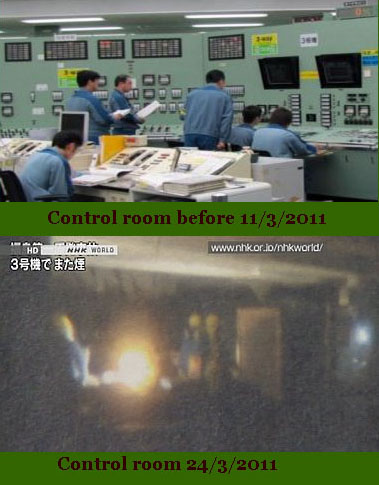
The Tokyo Electric Power Company says lights have been turned on inside the control room of the No.1 reactor building at the troubled Fukushima Daiichi nuclear plant. Thursday, March 24, 2011 11:56 +0900 (JST)
Mind you they said the same thing for reactor 3
This is complete rubbish...

Whats left of reactor 3...The mox/pox...site
Quote..." ALL the pictures of plant No. 3 show it's demolished! TEPCO says they are sending workers inside to restore electricity and fix it...YOU CAN'T WALK AROUND INSIDE! There is no inside..The whole building is demolished! Liars!..."
So there we go folks...I am calling...RED ALERT On this story...Red space...
Best comparision to the real situation so far
...Throw a car out of an airplane ...Then connect a battery to it...?


27 March 2011
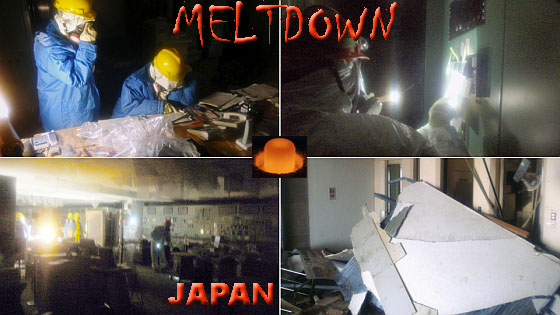
Interior of the Fukushima plant.
The following information releases come from the Japanese government, TEPCO and the Japanese media. These statements are designed to keep the public informed up to the minute and fully aware of what to do at all times:
- "Radiation is leaking from reactor #3"
- "No leakage detected at Fukushima reactors"
- "Radiation levels 'extremely high' 30km from Fukushima plant"
- "Radiation levels normal at plant. Residents are safe."
- "Nuclear iodine and cesium detected in Tokyo water supply"
- "All water supplies are safe, says Prime Minister"
- "Vegetables in Fukushima and Iwaki prefectures test 'dangerously high' radiation levels."
- "Government says all Japanese foods safe to eat"
- "Two reactors on fire!"
- "TEPCO reports all reactors under control at plant"
- "Smoke seen rising from reactor #4 at Fukushima Dai-ichi"
- "Smoke from nearby brushfire -- TEPCO official says"
- "Panic in Tokyo as residents, visitors and ex-pats jam Narita airport"
- "No panic reported in Tokyo, residents calm"
- "Anonymous government official pleas, 'Do not drink the water'!"
- "Water is safe for adults, says official. Infants should bathe 1/2 or less"
- "Fukushima plant has been abandoned, according to sources"
- Workers reported to be eager to remain at plant to 'control situation'"
- "Reactors may have melted down, says TEPCO spokesman"
- "No meltdowns yet, according to government officials"
- "Plant operator says radioactivity in water at reactor No. 2 10 million times usual level, workers evacuated"
- "Report of huge radiation spike at nuclear plant was mistake: TEPCO"
- "TEPCO official admits radioactivity in No. 2 too high to measure - Exceeded limit of gauge"
72,000 times the radiation of Hiroshima
Dr. Chris Busby verified today in an email that three spent fuel pools are totally blasted away and burned up. That puts the approximate radiation levels at 24,000 HIROSHIMAS x 3 = 72,000 times the radiation of Hiroshima now in the atmosphere. Remember, this is JUST from the spent fuel pools. Radiation escaping from the reactors is another story altogether.
We have now all had time to evaluate what we believe is the truth behind the Japanese Nuclear Incident (or should I say disaster) and it has become clear that we have all been deceived by the Japanese Authorities, their nuclear establishment, the IAEA, the international pro nuclear groups and more importantly the so called experts that are invited onto the mainstream media channels to blast us with nothing more than total spin. We have heard from nuclear experts from Chatham House (the NWO voice box) and such people as Prof. Gerry Thomas from Imperial College London.
They all keep playing down this disaster without themselves fully understanding the implications on human health and the antiquated testing methods used in the assessment of potential victims. It is only when one listens to such people as Dr. Chris Busby that you get to understand the true picture of the side effects of contamination by ingestion i.e. depleted uranium etc.
Read More
Click for Helicopter film Fukushima reactors
27/03/11...You Tube...You decide if it's "under control"
........................................All the best...Take care...Indy


160 FREE e-books
While working on an edition of "RHS1 Earthwatch"... I Came across this list of 160 books while researching thought I would pass it on and say "Thank you" to whoever compiled it; all books are FREE & downloadable...Help yourselves folks...Regards...Indy
Gardening, Wild Foraging and Self Sufficiency
The City People's Book Of Raising Food
[link to www.scribd.com]
Encyclopedia of country living Carla Emery
[link to www.scribd.com]
The complete book of self sufficiency by John Seymour
[link to www.scribd.com]
Vegetable Gardening Encyclopedia With Special Herb Section
[link to www.scribd.com]
Gardening Without Irrigation - Dry Farming
[link to www.scribd.com]
Intensive Gardening For Profit And Self Sufficiency
[link to www.scribd.com]
Joy of Gardening
[link to www.scribd.com]
Indoor Gardening Secrets
[link to www.scribd.com]
Wild Edibles - Nutrition & Medicine
[link to www.scribd.com]
Herbal Manual - Herbal Medicine 1936
[link to www.scribd.com]
Culpeper's The Complete Herbal
[link to www.scribd.com]
Edible And Medicinal Plants
[link to www.scribd.com]
survival - how to make herbal preparations
[link to www.scribd.com]
Edible Rooftop Gardening
[link to www.scribd.com]
Handbook of Herbs and Spices, Vol. 1 - K. Peter
[link to www.scribd.com]
Handbook of Herbs and Spices, Vol. 2 - K. Peter
[link to www.scribd.com]
Culinary Herbs: Their Cultivation Harvesting Curing and Uses by Kains, M. G.
[link to www.scribd.com]
How-To Hydroponics - A HowTo Guide to Soilfree Gardening
[link to www.scribd.com]
bill mollison - permaculture design course
[link to www.scribd.com]
Saving Your Own Vegetable Seeds
[link to www.scribd.com]
Organic Gardener's Composting by Steve Solomon
[link to www.scribd.com]
Growing & Curing Tobacco
[link to www.scribd.com]
Organic Tobacco Production
[link to www.scribd.com]
grow organic potatoes
[link to www.scribd.com]
Home Composting Bins
[link to www.scribd.com]
Organic Insecticides For The Garden; Home & Garden
[link to www.scribd.com]
Barrel-ponics
[link to www.fastonline.org]
An Integrated Fish Culture Hydroponic Vegetable Production System
[link to www.fastonline.org]
The One Straw Revolution _excellent (no tilling or plowing) permaculture
[link to ebooks.du.ac.in]
Food Preservation _Cooking, Canning, Curing, etc.
Preserving Food: Drying Fruits And Vegetables - Nutrition
[link to www.scribd.com]
Complete Guide To Home Canning
[link to www.scribd.com]
Canning Meat, Wild Game, Poultry, & Fish Safely
[link to www.scribd.com]
Preparing And Canning Fermented Food And Pickled Vegetables
[link to www.scribd.com]
Every Step in Canning
[link to www.scribd.com]
Small-Scale Food Drying Technologies
[link to www.scribd.com]
Field Care Of Harvested Big Game
[link to www.scribd.com]
How To Build A Wood-Fired Oven & Start A Home Bakery
[link to www.scribd.com]
Solar Cookers - Natural Living
[link to www.scribd.com]
Earth-Friendly Cooking Technologies
[link to www.scribd.com]
Solar Distillation & Water Purification
[link to www.scribd.com]
Rain Water Harvesting
[link to www.scribd.com]
How To Make An Upesi Stove
[link to www.scribd.com]
Wood Conserving Cook Stoves - A Design Guide
[link to www.scribd.com]
How To Make Liquor With Fruit And Berries
[link to www.scribd.com]
Cheese Making Made Easy
[link to www.scribd.com]
Cheese Making
[link to www.scribd.com]
Canning Meat, Wild Game, Poultry, & Fish Safely
[link to www.scribd.com]
Water
Handpumps for Domestic Rainwater Tanks
[link to www.cd3wd.com]
Using Treadle Pumps
[link to www.cd3wd.com]
Treadle Pumps _Non-motorized Irrigation
[link to www.cd3wd.com]
Recommendations for Designing Rainwater Harvesting System Tanks
[link to www.cd3wd.com]
Water Well Manual
[link to www.scribd.com]
Windmill Construction Manual
[link to www.scribd.com]
Heating, Energy and Fuel
Solar Water Heaters
[link to www.scribd.com]
Water as Fuel
[link to www.scribd.com]
Run Car on Water - stanley meyer resonant electrolysis cell system collection
[link to www.scribd.com]
Homemade Batteries [2003, 14 Pages]
[link to www.scribd.com]
Wind Energy Systems
[link to www.scribd.com]
Wood Burning Handbook
[link to www.scribd.com]
Oil Drum Stove For Cooking And Water Heating
[link to www.scribd.com]
Water Power For The Farm
[link to www.scribd.com]
Pumping Water For Irrigation Using Solar Energy
[link to www.scribd.com]
Generator Power For The Homestead
[link to www.scribd.com]
How To Make Biodiesel Fuel
[link to www.scribd.com]
Build Your Own Biogas Generator
[link to www.scribd.com]
Using A Biogas Digester
[link to www.scribd.com]
Livestock
Small-Scale Chicken Production
[link to www.scribd.com]
The Homesteader's Handbook To Raising Small Livestock
[link to www.scribd.com]
A Poultry Mini-Manual
[link to www.scribd.com]
Small-Scale Freshwater Fish Farming
[link to www.scribd.com]
Poultry a Practical Guide _Very old, Very excellent comprehensive guide
[link to www.scribd.com]
Hog trapping
8 documents and trap plans
[link to www.fastonline.org]
Poultry raising gold mine!
nearly 100 documents!
[link to www.fastonline.org]
Raising Rabbits start to finish
[link to www.fastonline.org]
Small Scale Dairy Production
[link to www.cd3wd.com]
Why and How to Keep Dairy Goats
[link to www.cd3wd.com]
Constructing a Simple Wooden Cart
[link to www.cd3wd.com]
Making a Straight Hame Collar
[link to www.cd3wd.com]
Single Donkey Harness for Cart Pulling
[link to www.cd3wd.com]
Medicine
Holistic & Alternative Medicine 101
[link to www.scribd.com]
Herbal/Medical Contraindications_ Using herbal remedies and pharma products: interactions
[link to www.swsbm.com]
Herbal Formulas for Clinic and Home
[link to www.swsbm.com]
First Aid Full Manual FM21-11
[link to www.scribd.com]
Where There is No Dentist - Murray Dickson
[link to www.scribd.com]
Where There Is No Doctor - A Village Health Care Handbook - David Werner
[link to www.scribd.com]
Wilderness Medicine Course
[link to www.scribd.com]
Healing Pets With Alternative Medicine
[link to www.scribd.com]
Physicians Desk Reference: Herbal Medicines
[link to www.scribd.com]
How To Treat and Heal Your Pet at Home?
[link to www.scribd.com]
ONE MINERAL CAN HELP _Potassium Iodide
[link to www.nogw.com]
Ditch Medicine - Advanced Field Procedures For Emergencies (1993)
[link to www.scribd.com]
Survival Manuals and Info
Compact Survival Kits
[link to www.scribd.com]
SAS Survival Guide
[link to www.scribd.com]
Wilderness Survival (FM 21-76)
[link to www.scribd.com]
Nuclear War Survival Skills
[link to www.scribd.com]
USMC Winter Survival Course
[link to www.scribd.com]
US Marine Corps Summer Survival Course
[link to www.scribd.com]
Survival Attitude
[link to www.scribd.com]
NUCLEAR CONTAMINATION AVOIDANCE
[link to www.scribd.com]
Kearny Homemade Fallout Meter
[link to www.scribd.com]
survival - personal wilderness medical kit
[link to www.scribd.com]
Building Related _Survival Shelters and More
Seven Survival Shelters That Could Save your life!
[link to www.scribd.com]
Building With Stone And Earth - Part 1
[link to www.scribd.com]
Building With Stone And Earth - Part 2
[link to www.scribd.com]
Barn Plans And Out-Buildings (1886)
[link to www.scribd.com]
How to build your own underground home
[link to www.scribd.com]
The Complete Book of Underground Houses _How To
[link to www.scribd.com]
the manual of free energy devices and systems
[link to www.scribd.com]
Communication
The Complete Manual Of Pirate Radio
[link to www.scribd.com]
Crystal Radio Project
[link to www.scribd.com]
Field Antenna Handbook
[link to www.scribd.com]
Shortwave Radio _Build Your Own
[link to www.scribd.com]
A Handbook On Shortwave Radio And LEO Sattelite Communication
[link to www.scribd.com]
Shortwave 101 - How To Listen To World Radio
[link to www.scribd.com]
Shortwave Radio Networking When Phones Fail
[link to www.scribd.com]
Other Skills and Useful Info
The Foxfire Books are simply some of the best old time skills books around!
Foxfire One
[link to www.scribd.com]
Foxfire Two
[link to www.scribd.com]
Foxfire Three
[link to www.scribd.com]
Foxfire Four
[link to www.scribd.com]
The Foxfire Five
[link to www.scribd.com]
Sharpening Small Tools
[link to www.scribd.com]
Farm Shop And Equipment
This publication offers suggested assortment of tools, special tools, and how to keep and care for them.
[link to www.scribd.com]
Tools For Agriculture - A Guide To Appropriate Equipment
Appropriate Equipment For Small Farms
[link to www.scribd.com]
Soapmaking - How To Make Soap
[link to www.scribd.com]
Village Technology Handbook
[link to www.scribd.com]
W.F. Vickery, Advanced Gunsmithing, 1940
[link to www.scribd.com]
Manual Of Bicycle Repair
[link to www.scribd.com]
The Formula Manual
Make your own recipes for almost everything other than food.
[link to www.scribd.com]
Land Clearing
[link to www.scribd.com]
Axe Manual of Peter McLaren
[link to www.scribd.com]
Crosscut Saw Manual
[link to www.scribd.com]
Basic Plumbing Skills
[link to www.scribd.com]
Basic Plumbing Course
[link to www.scribd.com]
Hoppe's Guide To Gun Care
[link to www.scribd.com]
Pistol Preventative Maintenance Guide
[link to www.scribd.com]
Emergency Sanitation At Home
Interesting DoD publication from 1958
[link to www.scribd.com]
Spinning With Simple Tools
[link to www.scribd.com]
Introduction To Spinning
[link to www.scribd.com]
Natural Dyeing Of Textiles
[link to www.scribd.com]
Handloom Construction
[link to www.scribd.com]
Blacksmithing Basics
[link to www.scribd.com]
Practical Blacksmithing 1891
[link to www.scribd.com]
Farm Blacksmithing 1921
[link to www.scribd.com]
Alternatives To Portland Cement
[link to www.scribd.com]
How To Make Candles
[link to www.scribd.com]
Candle Making
[link to www.scribd.com]
Hide tanning
4 documents
[link to www.fastonline.org]
Pond Construction and Management
about 50 documents
[link to www.fastonline.org]
Fighting fires
[link to www.cd3wd.com]
This is a great resource site for homesteaders, people interested in sustainability and survival techniques. There is so much here that the site deserves its own listing.
Downloading directly from the site is free, but does require sign up and some information (including info on what you plan on doing with the materials provided). It's worth it!
[link to www.itdg.org]
This is yet another almost incredible information resource for all things homestead. It will take time, but is well worth the dig and everything is available for free download.
[link to www.fastonline.org]

MARS!

Latest news reports and images from Mars
Published by www.Rockhoundstation1.com Hellas City; Mars
Published by www.Rockhoundstation1.com Hellas City; Mars

Optica first dog on Mars.
Back Issues of Earthwatch: Edition1: Edition2 Edition3: Edition4: Edition5: Edition6: Edition7: Edition8: Edition9: Edition10:
Contact Sally RHS1 Webmistress
Page manager...Indiana :

RHS1 Earthwatch 13 contains copyrighted material the use of which has not always been specifically authorized by the copyright owner. We are making such material available to our readers under the provisions of "fair use" in an effort to advance a better understanding of political, economic and social issues. The material on this site is distributed without profit to those who have expressed a prior interest in receiving it for research and educational purposes. If you wish to use copyrighted material for purposes other than "fair use" you must request permission from the copyright owner.
Contributing information and images: Courtesy of Wikipedia.
Reproduced under GPL license:Click here to view license::
This site is copyright © 2005-6-7-8-9
rockhoundstation1.com
All rights reserved.
Top of Page









